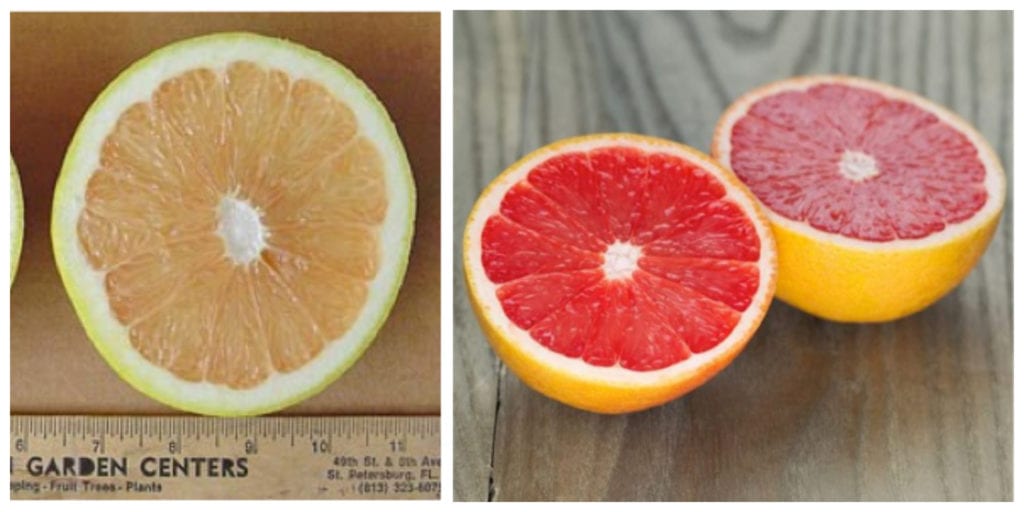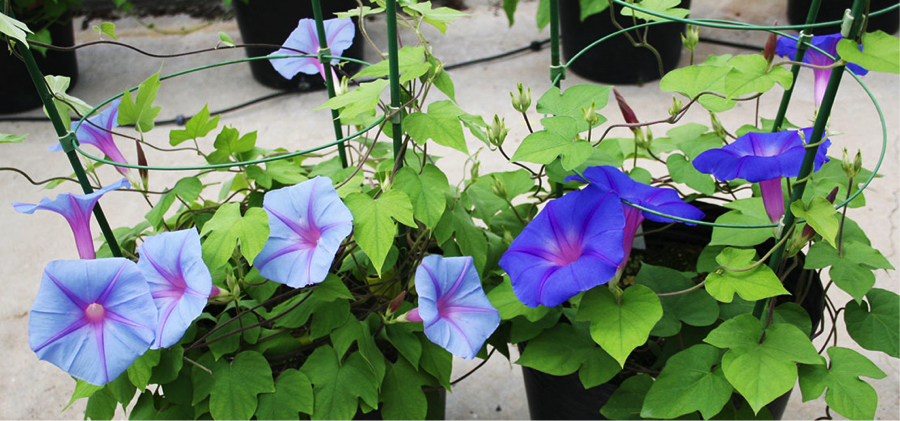The following is part of the “Approaches for Crop Improvement Blog Series”
Approaches for Crop Improvement: Mutagenesis
Back in 1929, a grapefruit grower in Texas noticed that one of his trees was producing red-fleshed fruit, an anomaly to the standard pink fruit of the early 20th century. This characteristic was the result of a mutation event, a spontaneous change in the genetic code that would forever change grapefruit. That fruit was selected for and eventually became what we now know as the Ruby Red grapefruit.

The standard pale pink fruit of the early 1900s (left). The red-fleshed Ruby Red fruit that was discovered after a mutation event (right).
As you can see, these spontaneous mutations or changes have brought us the fruits we know today. But what if that red-fleshed fruit hadn’t been noticed, and the genetics of that tree had not been perpetuated? How many years would it take for that coveted Ruby Red color to arise again?
The incidence of the red-fleshed vs. pink-fleshed grapefruit is an example of natural variation, which is historically the underlying basis of crop improvement. Natural variation is when there is more than one possible appearance for a single trait, i.e., eye colors in humans, different fruit and vegetable colors, or different shapes as is seen in peppers (think bell vs. chili peppers). All of these variations occur naturally, due to mutation events that have already occurred within a species to make a particular variation possible. Furthermore, these mutations are still occurring in modern species, as we have seen with the Ruby Red grapefruit in 1929 where the new red fruit color spontaneously appeared in a single tree. However, mutations do not always create desirable characteristics that are able to persist in nature. For example, in the animal kingdom, lions with white fur occur due to a mutation, but these animals are less likely to grow to adulthood because their white coloring makes them an easy target for predators.
Nonetheless, there are beneficial mutations that allow for new desirable characteristics to appear, and in turn, be selected by plant breeders and perpetuated in new crop varieties. Although this natural variation has been the foundation of plant breeding, these chance mutations, and waiting for them to spontaneously happen, affects the ability of plant breeders to generate significant improvements in a short time period. A desired characteristic might not already exist, and waiting for the specific mutation to cause that variation is impractical, as it could take thousands of years to naturally occur if it at all. To circumvent this time barrier, the technique of mutagenesis, or mutation breeding, has become a novel and popular tool among plant breeders.
Mutagenesis is the act of changing the genetic code of an organism. In mutation breeding, plant breeders use what are called mutagens, chemical or physical methods that cause changes within the DNA of the plant. These agents randomly change the DNA, creating mutations that lead to genetic variation that can serve as the building blocks of crop improvement. As in traditional plant breeding, breeders then select for desired qualities among the mutant plants and bring the best plants forward for future breeding. The difference here is time: by inducing mutation breeders are effectively widening the pool of genes they have available to choose from at a quicker rate than natural variation can. It is kind of like expanding the range of paint colors available to an artist to create a painting.
Types of Mutagenesis
The first documented instance of mutagenesis occurred in the 1920s at the University of Missouri when researcher Lewis Stadler was able to change the outward appearance of barley using gamma radiation. This type of mutagenesis, referred to as radiation breeding, has generated thousands of mutant plants whose desired attributes have been bred into new plant varieties, such as the light blue morning glory pictured below. Other mutational breeding techniques involve the use of chemicals such as ethyl methanesulfonate (EMS), though this approach is more commonly used in experiments to study the function of genes by knocking out their function and then looking for a change in a specific plant characteristic.

Light blue Ipomoea indica (Morning Glory) produced from gamma radiation” (left), original variety (right). Image from the Institute of Radiation Breeding: http://www.naro.affrc.go.jp/archive/nias/eng/org/GR/IRB/.
Interestingly, mutational breeding in plants is largely unregulated despite the induced changes to the genetic code of the plant. Most mutant lines generated are publicly available to plant breeders and can be used to create new varieties with no oversight. Crop varieties produced as the result of mutagenesis can even go on to be grown and certified as Organic, unlike genetically engineered varieties. Due to the lack of regulation, mutational breeding is a quick, cost-efficient way to bring new varieties to the market.
One limitation of mutational breeding is that its effect on changing DNA is random, therefore, you cannot precisely affect the gene or characteristic of interest. As a result, large numbers of plants, even into the thousands sometimes, need to be evaluated. Although we are able to rapidly increase the rate at which mutations occur, there is no guarantee that we will generate the characteristics desired. The techniques covered today don’t allow for the targeting of specific genes, and there is no way to tell how a specific mutation may affect gene function—all of which limits the precision of the method and makes it difficult to produce the desired outcomes. This has led to development of more targeted crop improvement tools, which we will cover in more detail in the future. But despite the lack of specificity of mutation breeding, over 3200 different plant varieties have been produced from this technique, making it a valuable tool for crop improvement.
